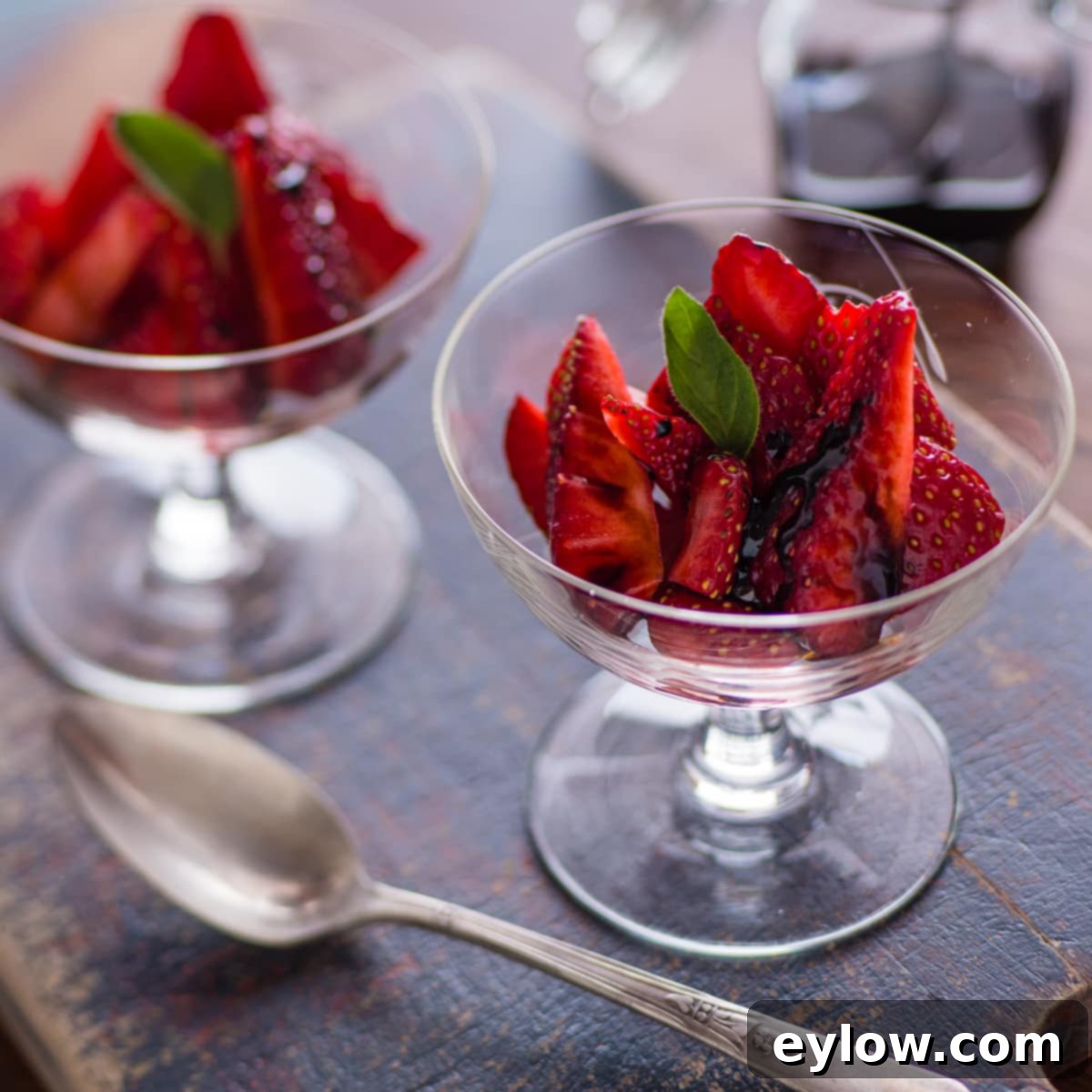Sweet & Tangy: The Ultimate Balsamic Strawberries with Homemade Glaze
Balsamic strawberries might sound like an unconventional combination, but they represent a truly exquisite pairing. This delightful dessert brings together the vibrant sweetness of fresh, juicy berries with the rich, complex tang of a homemade balsamic vinegar reduction, often referred to as balsamic glaze or balsamic syrup. The result is a simple yet incredibly elegant treat that’s surprisingly easy to prepare. In just minutes, you can create a sophisticated dessert that stands beautifully on its own, or serves as a luxurious topping for ice cream, frozen yogurt, or even layered with a cloud of whipped cream for an effortless summer indulgence. As a bonus, this guide includes a quick and easy recipe for crafting your very own balsamic glaze at home, ensuring the freshest and most flavorful experience.

Perched conveniently near my stovetop is a small squeeze bottle, a trusty companion filled with an intensely flavorful, dark brown elixir – my homemade balsamic glaze. A mere drizzle of this concentrated syrup possesses the magical ability to elevate almost any dish it touches, transforming the ordinary into something extraordinary. While “healthy” and “dessert” are terms that rarely find themselves in the same sentence, this particular recipe triumphantly defies that notion. The natural, sun-kissed sweetness of perfectly ripe strawberries harmonizes exquisitely with the tart, syrupy richness of the balsamic glaze. This creates a dessert that masterfully balances light, refreshing notes with an indulgent depth of flavor, making it a guilt-free pleasure you’ll want to revisit again and again.
This dessert isn’t just about contrasting flavors; it’s about enhancing them. The acidity of the balsamic doesn’t overpower the strawberries; instead, it brightens their natural sweetness and adds a sophisticated depth that a plain sugar syrup simply cannot achieve. It’s a testament to how simple ingredients, when thoughtfully combined, can yield truly remarkable culinary experiences. Whether you’re looking for a quick weeknight treat or an impressive finish to a dinner party, balsamic strawberries deliver on all fronts.
[feast_advanced_jump_to]
Why You’ll Adore These Balsamic Strawberries
Once you try this incredible dessert, you’ll quickly understand why it becomes a fast favorite. Its elegant simplicity and vibrant flavors are truly captivating. Here’s a closer look at what makes balsamic strawberries so irresistible:
- Effortless Elegance for Any Occasion: This dessert masterfully combines simplicity with sophistication. With just a handful of ingredients and minimal preparation time, you can create a light, flavorful, and visually appealing dessert that’s perfect for casual family meals or impressive enough for a dinner party. The vibrant red of the strawberries and the glossy dark sheen of the glaze create a stunning presentation without any fuss.
- Your Glaze, Your Way: Enjoy complete control over your balsamic experience. This recipe offers three convenient options for the balsamic glaze: opt for a high-quality store-bought version if you’re short on time, reduce balsamic vinegar directly for a purist’s approach, or follow our quick and easy recipe for a homemade balsamic syrup that tastes far superior and avoids the gums and thickeners often found in commercial products. Crafting your own glaze is a simple process that yields a smooth, balanced, and intensely flavorful syrup.
- Versatile Serving Options: Whether you prefer a rustic charm or a gourmet flourish, balsamic strawberries are incredibly adaptable. Serve them simply in elegant bowls for a fresh, healthy treat. For a more decadent touch, spoon them generously over creamy vanilla ice cream, tangy Greek yogurt, or luxurious mascarpone cheese. The contrast of textures and temperatures adds another layer of enjoyment to this already delicious dish.
- Celebrate Strawberry Season: This recipe is a true ode to strawberry season. When berries are at their peak – sweet, juicy, and bursting with flavor – this dessert allows their natural goodness to shine. It’s a refreshing, healthy, and incredibly satisfying summer indulgence that makes the most of nature’s bounty. You’ll find yourself eagerly awaiting the arrival of fresh strawberries just to make this dish again.
If you appreciate the unique savory-sweet balance that balsamic vinegar brings, you absolutely must try these balsamic glazed brussels sprouts – they are unbelievably delicious and showcase the versatility of balsamic beautifully!
Essential Ingredients for Your Balsamic Strawberry Creation
Creating this delightful dessert requires only a few key ingredients, each playing a vital role in the final flavor profile. Opting for the best quality ingredients will significantly enhance the taste and experience.
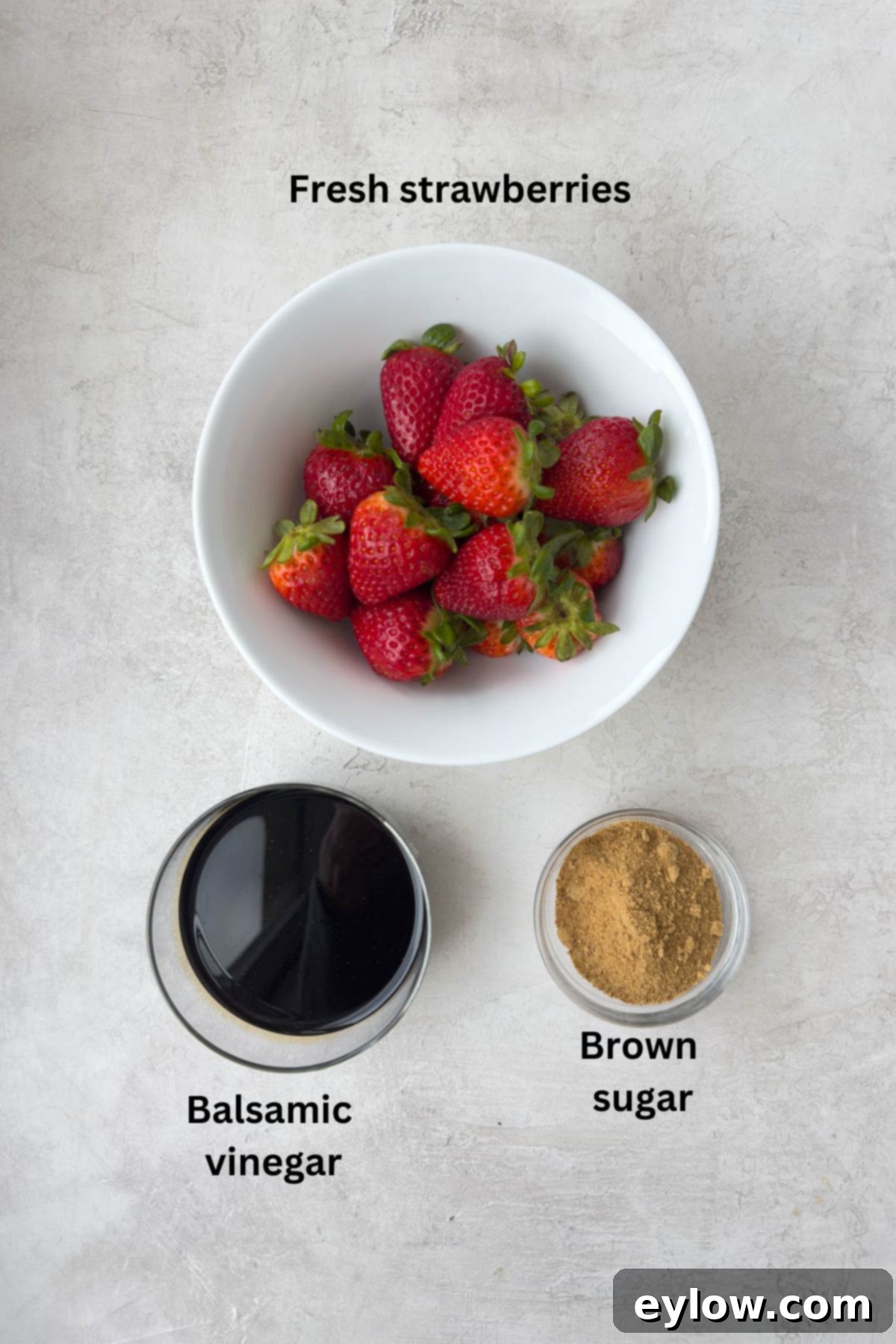
- Fresh Strawberries: The star of the show! It is crucial to use fresh, not frozen, strawberries for this recipe. Thawed berries tend to become excessively soft and watery, compromising the delightful texture that fresh strawberries provide. Always select berries that are vividly red, plump, and aromatic, as these indicators signify peak ripeness and optimal sweetness. For an even better experience, consider choosing organic strawberries, as they consistently appear on the EWG’s infamous Dirty Dozenlist due to pesticide residues, making organic a healthier choice where possible.
- Balsamic Vinegar: The key to your exquisite glaze. The quality of your balsamic vinegar directly impacts the flavor of your reduction. While you don’t need the most expensive aged balsamic, choosing a good-quality balsamic vinegar that isn’t overly thin or watered down is highly recommended. Homemade balsamic glaze, or balsamic syrup, almost always surpasses most store-bought alternatives, which are frequently thickened with gums and can result in a sticky, less refined texture. Making your own is a quick process and yields a wonderfully smooth, balanced, and intensely flavorful glaze that is truly worth the minimal effort. Look for balsamic with a good balance of sweetness and acidity, and always check the ingredient label for pure vinegar without added caramel coloring or thickeners.
- Brown Sugar (Optional for Glaze): This ingredient is entirely optional and only necessary if you are preparing your own balsamic glaze from scratch. A small amount of brown sugar helps the balsamic vinegar reduce and caramelize more effectively, creating a beautifully glossy, syrupy glaze with a deeper, richer flavor. Its molasses notes complement the vinegar beautifully. However, if your chosen balsamic vinegar is naturally sweet enough, or if you prefer a less sweet glaze, feel free to omit it. You can also use a sugar substitute like monk fruit for a zero-sugar option.
Detailed measurements for these ingredients can be found in the comprehensive recipe card below, ensuring you have everything you need for success. Always remember that fresh, high-quality components are the foundation of any truly memorable dish.
Exciting Substitutions and Creative Variations
One of the joys of balsamic strawberries is their adaptability. Feel free to experiment with these suggestions to tailor the dessert to your taste preferences or whatever ingredients you have on hand:
- Berry Medley Marvel: Elevate the visual appeal and introduce an extra layer of tartness by mixing in a handful of fresh raspberries alongside the strawberries. The vibrant color contrast is striking, and the raspberries’ slightly sharper flavor provides a wonderful counterpoint to the sweetness of the strawberries and the richness of the balsamic. Blackberries or blueberries can also be lovely additions.
- Aromatic Herb Infusion: For a sophisticated twist, finely slice fresh basil or mint leaves and gently sprinkle them over the top of your balsamic strawberries just before serving. Basil offers a surprisingly complementary peppery-sweet note that enhances the fruit, while mint provides a refreshing coolness that brightens the entire dish. A delicate chiffonade of either herb adds an unexpected gourmet touch.
- Creamy Indulgence: Transform this light dessert into a more luxurious experience with a creamy topping. A dollop of softly whipped cream, perhaps infused with a hint of vanilla extract, adds a cloud-like richness. For a fresher, tangier alternative, use lightly sweetened Greek yogurt or even a spoonful of creamy mascarpone cheese. These additions provide a delightful textural contrast and mellow the intensity of the balsamic glaze.
- Dessert Transformation: Beyond just berries, this dish is phenomenal when served over a scoop of your favorite ice cream. Classic vanilla ice cream or a scoop of creamy frozen yogurt provides a cool, sweet canvas that perfectly balances the tangy balsamic glaze and fresh fruit. It’s an instant upgrade to a simple scoop of ice cream. Alternatively, serve over a slice of angel food cake, pound cake, or even a light sponge for a more substantial dessert.
- Adjusting Sweetness: The sweetness of strawberries can vary greatly depending on the season and variety. If your berries aren’t as sweet as you’d like, don’t hesitate to sprinkle in a touch of granulated sugar or a monk fruit-allulose blend to taste. Allow the berries to macerate for a few minutes with the added sweetener; this process draws out their natural juices and creates a lovely, light syrup that blends with the balsamic glaze.
Another delightful sauce idea: If you’re a chocolate enthusiast and prefer a rich, velvety topping for your strawberries, consider making this homemade chocolate syrup. In fact, for the ultimate indulgence, serve both the balsamic glaze and chocolate syrup alongside your strawberries – they are surprisingly good together and offer a dynamic flavor experience!
Step-by-Step Guide: Crafting Your Balsamic Strawberries
This recipe is incredibly straightforward, allowing the natural flavors to shine with minimal effort. Here’s how to prepare your perfect balsamic strawberries:
Preparing the Strawberries
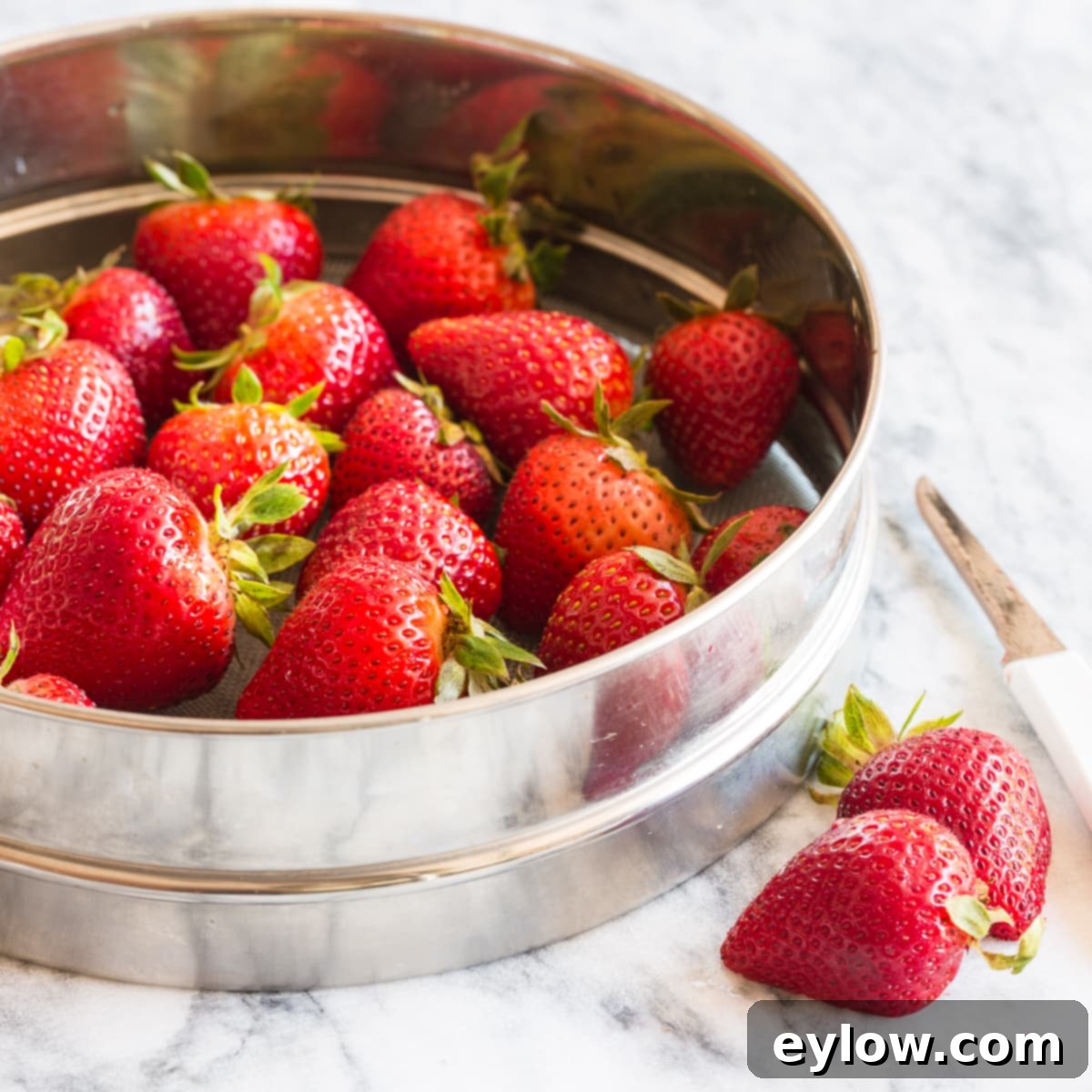
The first step to any great strawberry dish is proper preparation. Begin by gently washing your fresh strawberries under cool running water. Avoid soaking them, as this can make them waterlogged. Once washed, thoroughly dry the strawberries using a clean kitchen towel or paper towels. This step is crucial, as excess water can dilute the flavors and prevent the balsamic glaze from adhering properly. After drying, hull the strawberries by removing the green caps and any woody cores. Then, slice them in halves or quarters vertically, depending on their size and your desired presentation. Smaller berries can be halved, while larger ones benefit from being quartered to create bite-sized pieces. Arrange these beautiful, prepared berries into individual serving bowls or elegant stemmed glasses for a more refined presentation. For additional serving inspiration, refer to the “Serving Suggestions” section towards the end of this article.
Crafting Your Homemade Balsamic Glaze
While store-bought options exist, making your own balsamic glaze is a simple process that yields a far superior result in terms of flavor and texture. It’s a game-changer for this recipe.
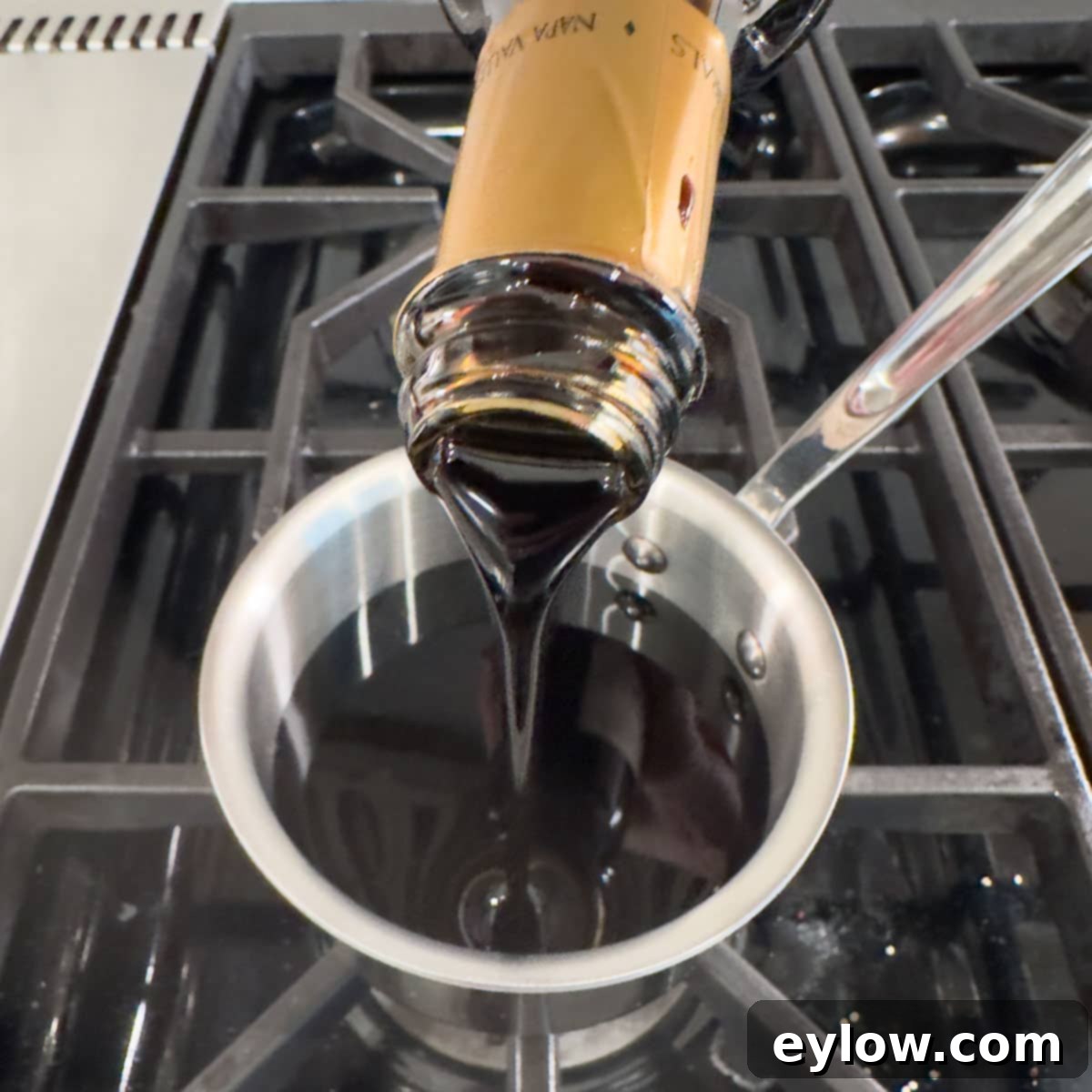

Chef’s Tip: Achieving Perfect Glaze Consistency. When making balsamic glaze, patience is key. The vinegar should simmer gently, not boil vigorously, to allow for gradual reduction and prevent scorching. You’ll notice the aroma intensifying and the liquid visibly thickening. To test for readiness, dip a spoon into the glaze and lift it out. If it coats the back of the spoon like a thin syrup, it’s ready. Remember that the glaze will continue to thicken considerably as it cools, so err on the side of it being slightly thinner than you desire when hot. If your homemade balsamic glaze accidentally thickens too much after cooling, don’t worry! Simply thin it to your desired consistency with a tiny splash of water or a few drops of balsamic vinegar. Once prepared, transfer your exquisite glaze into a squeeze bottle for easy drizzling or a small jar with a tight-fitting lid for storage. No refrigeration is typically needed for balsamic glaze, thanks to its high acidity and sugar content, making it a convenient staple to keep on hand.
For another fantastic way to utilize your homemade balsamic glaze, indulge in this savory yet sweet Fig, Goat Cheese and Prosciutto Crostini with Balsamic Glaze. The combination of salty prosciutto, creamy goat cheese, sweet figs, and tangy glaze is truly a culinary delight that highlights the versatility of this incredible reduction.
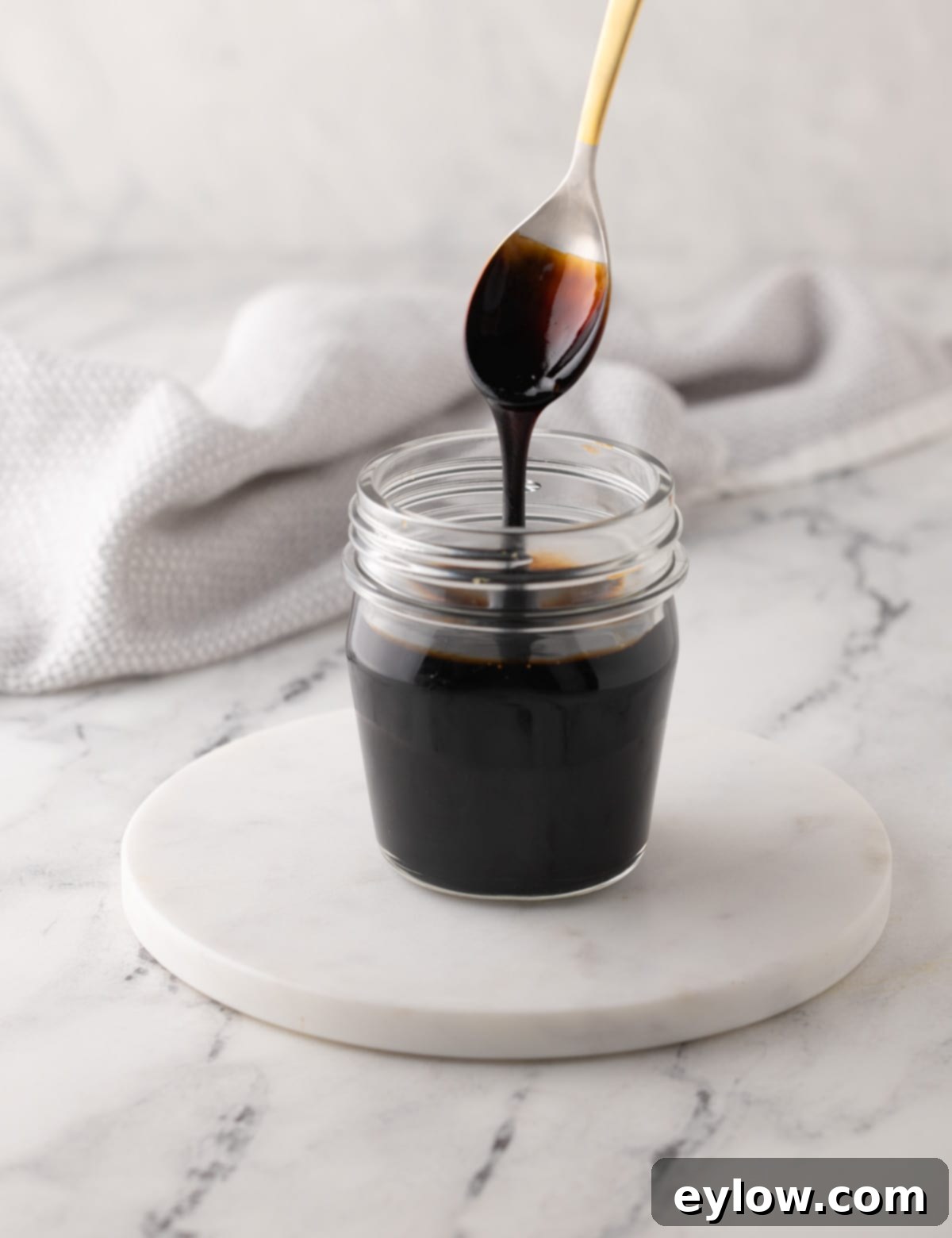
If you’re still craving more simple and delicious strawberry desserts, be sure to try this easy strawberry panna cotta recipe. A drizzle of your freshly made balsamic glaze would also be an outstanding addition to the panna cotta, adding a layer of complex flavor that elevates the entire dish.
Chef’s Tip: Navigating the World of Balsamic Vinegar. Balsamic vinegar is a diverse product, ranging from inexpensive supermarket bottles to highly prized, traditionally aged varieties that command a significant price. For a balsamic reduction, while you want a decent quality vinegar, there’s absolutely no need to splurge on the most expensive bottle. A mid-range balsamic will reduce beautifully and provide ample flavor. The most important thing is to **always read the label.** Avoid bottles with added caramel coloring, artificial flavors, or unnecessary thickeners (like gums), which can result in a less natural and often sticky glaze. Look for “Aceto Balsamico di Modena IGP” or “Aceto Balsamico Tradizionale di Modena DOP” for authentic options, though even a good quality “condimento” balsamic can work. Some high-quality balsamic vinegars are naturally syrupy straight from the bottle, making them perfect for drizzling without the need for reduction, such as this recommended barrel-aged balsamic vinegar. These can be a fantastic shortcut for when you’re truly short on time but still desire that rich balsamic flavor.
Beyond Strawberries: Discover More Uses for Balsamic Glaze
Once you have a batch of homemade balsamic glaze on hand, you’ll discover its incredible versatility. Think of it as a culinary secret weapon, a luxurious garnish that adds a touch of gourmet sophistication and a burst of flavor to an array of dishes, both sweet and savory. Its concentrated sweet-tart profile makes it a highly valuable ingredient in any kitchen.
- Elevate Everyday Vegetables: A quick upgrade for humble vegetables! Drizzle a little balsamic glaze over steamed or roasted green beans, asparagus, or even grilled zucchini. The sweet tang beautifully complements the earthy notes of the vegetables, transforming them into a side dish with restaurant-quality flair.
- Gourmet Appetizers in Minutes: Impress your guests with minimal effort. Smear soft goat cheese or creamy ricotta onto toasted baguette slices (crostini), then drizzle generously with balsamic glaze. For an added seasonal touch, top with fresh fig slices if available. This simple combination is always a crowd-pleaser.
- A Sophisticated Sauce for Proteins: Don’t limit balsamic glaze to desserts and appetizers. It makes a magnificent sauce for main courses! Brush it onto roast or grilled salmon, chicken breasts, pork tenderloin, or even beef. The glaze caramelizes beautifully, adding a rich, savory-sweet crust and an irresistible depth of flavor to your proteins.
- Enhance Soups: Swirl a small amount of balsamic glaze into pureed soups just before serving. It adds a surprising depth and a touch of acidity that can brighten and balance rich flavors, particularly in creamy vegetable soups like butternut squash or tomato. It’s a chef’s trick for adding a final flourish.
- The Classic Caprese Upgrade: Take your classic Caprese salad to the next level. Arrange slices of ripe tomatoes, fresh mozzarella, and fragrant basil leaves on a platter. Drizzle generously with your homemade balsamic glaze and a good quality extra virgin olive oil. The glaze ties all the flavors together beautifully.
- Pair with Other Fresh Fruits: Balsamic glaze isn’t just for strawberries! Explore its magic with other fresh fruits. Wrap small wedges of sweet cantaloupe or honeydew melon with salty prosciutto and finish with a elegant drizzle of balsamic glaze for a sophisticated appetizer. It’s also wonderful over peaches, figs, or even roasted pears.
And speaking of fresh strawberries, don’t miss out on incorporating them into these delightful Greek yogurt parfaits. They make for a refreshing breakfast that feels as indulgent as a dessert, packed with wholesome goodness.

Storage Guidelines: Ensuring Freshness and Longevity
Understanding how to properly store both the balsamic glaze and the fresh strawberries will help you enjoy this delightful dessert at its best and prevent food waste.
Homemade balsamic glaze boasts an impressive shelf life due to its naturally high acidity and sugar content, which act as powerful preservatives. Once prepared, it can be kept in an airtight container – such as a squeeze bottle or a well-sealed jar – at cool room temperature in your pantry for a very long time, often for several months or even longer without losing quality. Refrigeration is generally not necessary for the glaze itself. However, if you choose to refrigerate it, be aware that the cold temperature will cause it to thicken considerably. If this happens, simply allow it to warm up to room temperature for easier drizzling, or thin it with a tiny amount of water or extra balsamic vinegar if needed to achieve your desired consistency. An opened bottle of balsamic vinegar, stored tightly capped after use, typically lasts 12-18 months, so a homemade balsamic reduction will also remain good for an extended period. Always trust your senses; if it looks, smells, or tastes off after a very long period, it’s best to discard it.
Fresh strawberries, on the other hand, are much more perishable. To maximize their freshness, store unwashed berries in their original container or spread out in a single layer on a paper towel-lined tray in the refrigerator. They typically last about 3-5 days. It’s best to wash and slice them just before serving. If you prepare the balsamic strawberries (macerating them in the glaze), they are best enjoyed immediately. The acidity of the glaze can cause the berries to soften and release more juice over time, changing their texture. Since the recipe is so simple to assemble, there’s truly no need to make the dressed strawberries ahead of time; freshness is key for the best experience.
Elevate Your Experience: Creative Serving Suggestions
Balsamic strawberries are wonderfully versatile, lending themselves to a variety of presentations and accompaniments. Whether you’re aiming for a casual treat or an elegant finale, these suggestions will help you serve them perfectly.
The simplest way to enjoy balsamic strawberries is to serve them at room temperature or lightly chilled in a small, attractive bowl, generously drizzled with the glossy balsamic glaze. For a touch of refined elegance, arrange the vibrant berries in martini-style stemmed glasses or champagne coupes. This elevates the visual appeal and makes them feel like a special occasion dessert. Beyond serving them plain, they are truly wonderful spooned over a scoop of creamy vanilla ice cream, tangy frozen yogurt, or a slice of rich pound cake. The interplay of warm cake or cold ice cream with the fresh berries and zesty glaze creates a delightful sensory experience.
For those seeking an utterly decadent and over-the-top dessert experience, start with one of these rich gluten-free chocolate brownies. Top it with a generous scoop of your favorite ice cream, then pile on the fresh balsamic strawberries. The combination of fudgy chocolate, cold creaminess, bright fruit, and tangy glaze is an unforgettable explosion of flavors and textures.
Some culinary enthusiasts enjoy a delicate grind of fresh black pepper over their balsamic strawberries, believing it adds an intriguing layer of spice that complements the fruit and vinegar. While it’s an interesting variation, I personally prefer the pure, unadulterated flavors of the berries and glaze without it. Feel free to experiment and discover your own preference!
Frequently Asked Questions About Balsamic Strawberries
Here are answers to some common questions you might have about preparing and enjoying this delicious dessert:
For the best possible texture and flavor, we strongly recommend using fresh strawberries for serving balsamic strawberries. Frozen strawberries, once thawed, tend to become very wet, soft, and somewhat soggy, which significantly compromises the delightful bite and firmness that fresh berries provide. If frozen berries are your only option, you can still enjoy the flavors by thawing them and then mashing them lightly with a fork. Serve this strawberry compote-like mixture with balsamic glaze over ice cream, frozen yogurt, or a slice of cake. However, we encourage you to try the recipe again when you can acquire good quality fresh strawberries to truly appreciate the intended experience.
To ensure the freshest taste and best texture, it is always best to keep fresh strawberries stored separately in the refrigerator and only dress them with the balsamic glaze just before you are ready to serve. Homemade balsamic glaze (or balsamic syrup) is quite stable and can last unrefrigerated for many weeks, even months, due to its high acidity and sugar content. Fresh, unwashed strawberries typically last in the refrigerator for about 3 to 5 days. Once you macerate, or mix, the strawberries with the balsamic glaze, they are best served immediately. Over time, the acidity of the glaze will cause the berries to release their juices and soften, resulting in a less desirable texture. Since this dessert is incredibly simple and quick to assemble, there’s no real benefit to making the dressed strawberries ahead of time – freshness is key!
The amount of sugar needed for your balsamic glaze is largely dependent on the natural sweetness of the balsamic vinegar you choose and your personal preference. Many good quality balsamic vinegars possess a lovely natural sweetness, meaning you might not need to add any sugar at all. If you do find your glaze too tart after reduction, start by stirring in just a teaspoon or two of brown sugar. Taste the glaze, and then add a little more if desired, adjusting until it reaches your perfect balance of sweet and tangy. For a zero-sugar alternative, a monk fruit-allulose blend can be used effectively. Another excellent sweetening option, especially for a smooth consistency, is a simple syrup made with monk fruit. Remember, it’s easier to add more sweetness than to take it away, so always add gradually and taste as you go.
Explore More Delightful Strawberry Recipes
Strawberries are incredibly versatile and shine in a wide array of dishes beyond dessert. They bring a burst of freshness and natural sweetness to many culinary creations. For instance, they are fantastic in vibrant summer salads, offering a sweet counterpoint to savory ingredients. Try this refreshing strawberry salad which pairs beautifully with creamy goat cheese or salty feta cheese for an unexpected flavor combination.
Don’t let your leftover strawberries go to waste! Here are some more inspiring recipes to make the most of this wonderful fruit:
- Fast and Fresh Strawberry Coulis
- Super Moist Lemon Olive Oil Cake Recipe
- How to Make Sabayon
- Gluten Free Strawberry Muffins
⭐️ Share Your Experience: Did You Make This Recipe?
If you’ve had the pleasure of making this delightful balsamic strawberries recipe, we would absolutely love to hear from you! Please take a moment to leave a comment below and share your thoughts. Your feedback is incredibly valuable to us and to other readers who are considering trying the recipe. If you truly loved it, a 5-star rating would be greatly appreciated! Your ratings and comments genuinely help our community grow and allow more people to discover and enjoy these fantastic recipes.
📖 Recipe
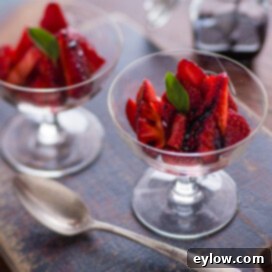
Balsamic Strawberries
Sally Cameron
Pin Recipe
Equipment
-
Small saucepan for reduction
Ingredients
- 1 12-ounce bottle good quality Balsamic vinegar
- 1 pound fresh strawberries washed, hulled, and quartered
Optional Ingredients (if needed for glaze)
- 1 tablespoon brown sugar or a monk fruit-allulose blend, to taste
Instructions
Prepare the Balsamic Glaze
-
Pour the balsamic vinegar into a small saucepan (1-2 quart size is ideal). Bring it to a gentle simmer over low heat. Allow it to reduce slowly by about one-third, meaning from 12 ounces down to approximately 8 ounces. It’s crucial to watch the glaze carefully during this process to prevent it from burning or reducing too much, which can make it overly thick. Stir or whisk the vinegar occasionally to ensure even reduction.
Once reduced, taste the glaze. If you find it naturally sweet enough for your preference, remove it from the heat and let it cool completely. Then, transfer it to a small glass jar with a tight lid or a convenient squeeze bottle for easy storage and drizzling.
If the glaze is too tart for your liking, you can stir in a little brown sugar (starting with 1 teaspoon and adding more to taste) or use a simple syrup (consider making one with monk fruit for a zero-sugar option, as mentioned in the FAQ). Continue to gently warm and stir until the sugar is dissolved.
If, after cooling, your balsamic glaze becomes too thick, don’t worry! You can easily thin it by stirring in just a tiny amount of water or a few drops of balsamic vinegar until it reaches your desired drizzly consistency.
Assemble the Strawberries
-
Begin by washing and carefully stemming the fresh strawberries. Depending on their size, slice them in half vertically or into quarters. Arrange these prepared berries neatly into individual small bowls or elegant stemmed glasses for serving. Just before serving, generously drizzle the homemade balsamic glaze over the strawberries. For the best taste and texture, serve immediately.
Notes
- For a delightful contrast, serve with a dollop of softly sweetened whipped cream or a spoonful of mascarpone cheese.
- Enjoy them as a fresh and healthy breakfast or snack over a bowl of plain or vanilla Greek yogurt.
- Elevate a simple dessert by spooning them over a scoop of vanilla ice cream, frozen yogurt, or a slice of pound cake.
Even More Versatile Uses for Homemade Balsamic Glaze:
- Use it to “dress” a plate in a fancy restaurant style by adding a squiggly line or decorative dots.
- Drizzle onto toasted baguette slices (crostini) smeared with soft goat cheese for an easy yet elegant appetizer. Add fresh fig slices when in season for an extra layer of flavor.
- Employ it as a sophisticated sauce for main courses, such as roast or grilled salmon, chicken, or pork.
- Garnish rich, pureed vegetable soups, like butternut squash or tomato soup, to add a touch of acidity and depth.
- Enhance a classic Caprese salad (sliced tomatoes, fresh mozzarella, basil) with a generous drizzle of glaze and good olive oil.
- Experiment with other fresh, sweet fruits like peaches, figs, or even cantaloupe wrapped in prosciutto for a unique sweet-savory combination.
Homemade balsamic glaze is incredibly stable and lasts almost indefinitely at room temperature due to its high acidity and sugar content. Store it in an airtight container in a cool pantry. While refrigeration is not necessary, if you choose to refrigerate, note that it will thicken from the cold; simply let it warm up or thin with a little water if needed. Always perform a quick taste test if it’s been stored for many months to ensure the flavor is still optimal.
